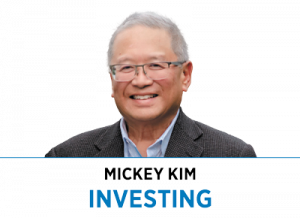Subscriber Benefit
As a subscriber you can listen to articles at work, in the car, or while you work out. Subscribe Now Two short years ago, it was a dark time for U.S. financial markets as the Federal Reserve’s crusade against inflation resulted in record destruction of wealth. In 2022, U.S. stocks had their worst performance since the depths of the global financial crisis in 2008, with the “bear market” erasing almost $13 trillion in market value.
Two short years ago, it was a dark time for U.S. financial markets as the Federal Reserve’s crusade against inflation resulted in record destruction of wealth. In 2022, U.S. stocks had their worst performance since the depths of the global financial crisis in 2008, with the “bear market” erasing almost $13 trillion in market value.
Fast forwarding, investors with fortitude were amply rewarded, as the S&P 500 finished 2024 up a whopping 65.4% from its bear-market low on Oct. 12, 2022.
Indeed, the front-page headline of the Dec. 31, 2024, edition of The Wall Street Journal trumpeted “Stocks Cap Best Two Years in a Quarter-Century,” as the S&P 500 posted back-to-back annual gains of more than 20% for the first time since 1997 and 1998.
Given the strong performance of the S&P 500, which was driven by the spectacular performance of a small handful of mega-capitalization technology stocks (aka the “Magnificent Seven”—Apple, Microsoft, Alphabet, Amazon, Nvidia, Meta and Tesla), investors are curious if U.S. stocks are in a “bubble” that is destined/doomed to burst.
Howard Marks is co-chair of Oaktree Capital Management and one of the brightest minds in investing. I’ve referenced his writings frequently and found his most recent memo, “On Bubble Watch,” particularly timely and insightful.
Marks pointed out that in just the first decade of this century, “investors had the opportunity to participate in—and lose money due to—two spectacular bubbles.” The first was the “dot-com” or tech-media-telecom bubble of the late 1990s, which began to burst in mid-2000. The second was the housing/subprime mortgage bubble of the mid-2000s.
Bubbles have been around as long as FOMO (the fear of missing out), and the sight of your boastful friend getting rich have driven otherwise rational investors to suspend disbelief and even common sense. Indeed, according to Marks, “a bubble or crash is more a state of mind than a quantitative calculation.” Thus, financial markets have always been and will always be subject to bubble thinking.
In Marks’ view, “a bubble not only reflects a rapid rise in stock prices, but it is a temporary mania characterized by—or perhaps better, resulting from—the following:
◗ highly irrational exuberance;
◗ outright adoration of the subject companies or assets, and a belief they can’t miss;
◗ massive fear of being left behind if one fails to participate; and
◗ resulting conviction that, for these stocks, ‘there is no price too high.’”
“Newness” and “this time is different” causes or permits investors to suspend rationality and engage in bubble thinking, Marks says. Indeed, bubbles are invariably associated with new developments, such as the perceived unlimited potential of the internet and the financial alchemy transforming subprime mortgages into bulletproof bonds that led to the two most recent bubbles. If something is new (like artificial intelligence), there is by definition no history or anything to temper enthusiasm.
Recalling Hans Christian Andersen’s “The Emperor’s New Clothes,” Marks argues, “Most people would rather go along with a shared delusion that’s making investors buckets of money than say something to the contrary and appear to be dummies. When a whole market or group of securities is blasting off and a specious idea is making its adherents rich, few people will risk calling it out.”
There’s always a grain of truth underlying every bubble. It just gets taken too far. The S&P 500 finished 2024 up 65.4% from its October 2022 low, but Nvidia (NVDA), which manufactures advanced chips needed to develop AI platforms, was up 1,067.7% (almost twelvefold—to a market value of $3.3 trillion). Investors are betting on the persistence of both the growing transformative potential of AI and Nvidia’s position as key supplier to the “arms race” in AI.
However, investors forget the “disrupters can be disrupted, whether by skillful competitors or even newer technologies.” On Jan. 27, investors dumped Nvidia and other AI-related stocks en masse on fears a new Chinese competitor, DeepSeek, had developed a cheap AI platform. DeepSeek’s claims are difficult to verify, but Nvidia lost almost $600 billion of value, a record one-day loss for any company on Wall Street.
Similarly, the 20 largest stocks in the S&P 500 at the end of 1999 were Microsoft, Cisco Systems, General Electric, Walmart, Exxon Mobil, Intel, Citigroup, IBM, Oracle, Home Depot, Merck, Coca-Cola, Procter & Gamble, AIG, Johnson & Johnson, Qualcomm, Bristol-Myers Squibb, Pfizer, AT&T and Verizon. By the end of 2024, only Microsoft, Walmart, Exxon Mobil, Johnson & Johnson, Procter & Gamble and Home Depot remained.
Bubbles are obvious only in hindsight, but Marks observes that “investors treat the leading companies—and pay for their stocks—as though the firms are sure to remain leaders for decades. Some do and some don’t, but change seems to be more the rule than persistence.”
Be careful! •
__________
Kim is Kirr Marbach & Co.’s chief operating officer and chief compliance officer. He can be reached at 812-376-9444 or mickey@kirrmar.com.
Please enable JavaScript to view this content.
